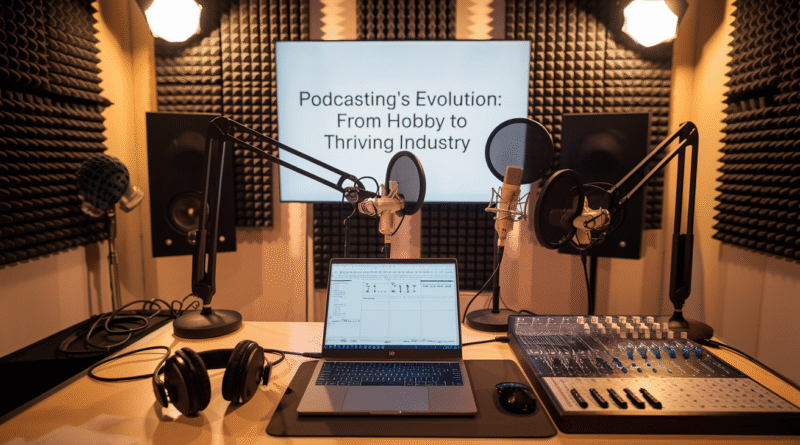Podcasting’s Evolution: From Hobby to Thriving Industry
Podcasting, which initially began as a niche hobby for tech enthusiasts and passionate storytellers, has rapidly grown into a billion-dollar industry over the past decade. Originally a grassroots platform where unfiltered voices reached small, dedicated audiences, it has now evolved into a major source of entertainment, news, and education with widespread mainstream appeal. This rise in professional podcasting has reshaped content creation, redefined business models, and opened up opportunities for creative entrepreneurs and media companies alike. This article explores the key factors that have propelled podcasting from a simple hobby to a thriving industry.
Podcasting’s Growth
Though podcasting started in the early 2000s, it only began to gain real traction with the rise of smartphones and widespread internet access. Platforms like Apple Podcasts and later Spotify made podcasts easily accessible, allowing users to listen on the go, which sparked a boom in popularity. Between 2008 and 2013, podcasting remained largely a hobbyist activity with limited advertising and few monetization options.
Things began to change around 2014 with the release of Serial, a true-crime podcast that became a cultural sensation. Serial’s success showed the potential of long-form audio storytelling and set the stage for future podcast hits. The audience for podcasts grew rapidly, and by 2020, over 100 million Americans were tuning in monthly, marking the shift of podcasting from niche to mainstream.
Podcasting as a Business
As podcast audiences expanded, so did opportunities for monetization. Companies quickly recognized that podcasts were an effective advertising medium, especially for reaching niche audiences that traditional media often overlooked. By 2021, U.S. podcast ad revenue had surpassed $1 billion, with forecasts predicting it would hit $2 billion by 2023, according to the Interactive Advertising Bureau (IAB). Advertisers are drawn to podcasting’s ability to deliver highly engaged and targeted listeners, making ads more effective than in other forms of digital media.
Initially, smaller, direct-to-consumer brands dominated podcast sponsorships, but now large corporations have stepped in to harness the power of podcasts. Hosts often read ads themselves, making them feel like authentic recommendations rather than disruptive ads, leading to better engagement and higher conversion rates.
Beyond advertising, podcasts are generating revenue through subscription models and listener donations on platforms like Patreon. Spotify’s recent integration of subscription-based podcasts highlights the growing business potential of the medium.
The Professionalization of Podcasting
As the podcasting industry has matured, so too has the quality of production. Early podcasts often had a rough, unpolished feel, with minimal editing and makeshift home studios. Today, many top podcasts boast production quality on par with radio shows and TV documentaries. Professional studios and media companies like NPR, Wondery, and Gimlet Media now invest heavily in creating polished, high-quality content to attract larger audiences.
Podcast networks, such as Earwolf, Radiotopia, and The Ringer, have also contributed to the professionalization of the industry. These networks group together shows under a single brand and provide creators with resources, marketing, and distribution, much like traditional media companies. Their support helps shows reach wider audiences and maximize revenue potential.
High-profile podcast deals have further validated the industry’s financial viability. Spotify, in particular, has made significant investments in podcasting, acquiring podcast networks and securing exclusive deals with top creators. In 2020, Spotify’s $100 million exclusive deal with The Joe Rogan Experience signaled the industry’s potential for massive investment and growth.
Democratization of Content Creation
Despite podcasting’s growing commercialization, it remains one of the most accessible forms of media production. Anyone with a microphone and a story to tell can start their own podcast, which has led to an explosion of diverse voices in the space. Independent creators, hobbyists, and marginalized communities have all found success alongside major media companies.
Podcasting continues to retain its grassroots appeal, even as the industry becomes more professionalized. Whether produced by a major studio or a lone creator recording from home, audiences appreciate the intimacy and authenticity that podcasts offer. The personal connection between hosts and listeners makes podcasting feel more direct and unfiltered compared to other media formats.
Platforms like Apple Podcasts, Spotify, and Google Podcasts have made global distribution easy for creators, while social media allows them to reach new audiences and build communities in ways that traditional radio and TV never could.
Expansion of Podcast Genres
Podcasting’s growth into a full-fledged industry can also be attributed to the expansion of its content and genres. While early podcasts focused on tech and niche subjects, today there are podcasts covering virtually every topic imaginable, from true crime and comedy to politics, cooking, self-help, and finance.
Genres such as true crime, news, and comedy continue to dominate the charts, but more specialized topics like history, personal finance, and mental health have also gained significant followings. Podcasting’s ability to cater to both broad and niche interests has helped the medium grow.
Podcasting has even transcended audio, with successful shows being adapted into other formats like TV series or books. For example, Homecoming, a scripted fiction podcast, was adapted into a TV show for Amazon Prime, and Lore, a podcast about folklore, became a television series. These cross-media successes demonstrate podcasting’s influence beyond audio content.
The Impact of COVID-19
The COVID-19 pandemic further accelerated podcasting’s growth into a professional industry. With lockdowns and social distancing measures in place, more people turned to podcasts for entertainment and information. Listenership surged, and new podcasts from celebrities and content creators emerged during this period.
Additionally, many businesses began using podcasts as internal communication tools for remote work, further driving the growth of corporate podcasts. The pandemic underscored podcasting’s resilience, as creators were able to continue producing content remotely without major disruptions, unlike film and TV productions.
Challenges and Future Outlook
Despite its growth, podcasting faces several challenges. Monetization remains difficult for many independent creators, who struggle to make their shows profitable. While top podcasts can generate significant revenue from ads and sponsorships, smaller creators often have a harder time securing meaningful income. This has driven interest in subscription models, where listeners pay directly for premium content.
Another ongoing issue is discoverability. With over 4 million podcasts available, it’s tough for new shows to stand out. Although recommendation algorithms are improving, creators still need to invest in marketing to reach their target audiences.
Looking forward, podcasting is set to continue its upward trajectory, especially as platforms like Spotify, Amazon, and YouTube increase their investment in the medium. Advancements in technology, including smart speakers and voice assistants, are also expected to drive further podcast consumption in the coming years.
Conclusion
Podcasting has grown far beyond its humble beginnings as a hobbyist’s passion project to become a major industry attracting millions of listeners and billions in revenue. Its unique combination of accessibility, authenticity, and professionalism has solidified its place in the media landscape. As creators and businesses continue to explore podcasting’s potential, the industry will keep evolving, offering new opportunities for content creators, advertisers, and listeners alike. Whether for entertainment, education, or communication, podcasting is here to stay and will only grow in influence in the years ahead.

